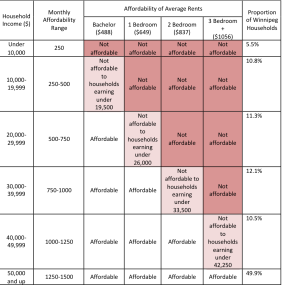Looking for information about housing in Winnipeg? Look no further – here you’ll find all kinds of facts and statistics about housing in Winnipeg and Manitoba.
References are available at the bottom of the page, in case you are looking for more details.
Core Housing Need
Definition of Core Housing Need
“Acceptable housing is defined as adequate and suitable shelter that can be obtained without spending 30 per cent or more of before-tax household income. Adequate shelter is housing that is not in need of major repair. Suitable shelter is housing that is not crowded, meaning that it has sufficient bedrooms for the size and make-up of the occupying household. The subset of households classified as living in unacceptable housing and unable to access acceptable housing is considered to be in core housing need.”(1)
Core Housing Need
In 2006: (2)
- 11.3 % of all MB households lived in core housing need (46,900 people)
- 24.0 % of MB renter households lived in core housing need (28,800 people)
- 6.2 % of MB owner households lived in core housing need (18,100 people)
- 22.3 % of those who immigrated to Canada between 2001 and 2006 lived in core housing need in Manitoba (1,600 people)
In 2006: (3)
- 37.3 % of Winnipeg tenant-occupied households spent over 30% of their income on housing.
- 11.6 % of Winnipeg owner-occupied households spend over 30% of their income on housing.
Renting in Manitoba
Current Vacancy Rates
In April, 2011, the vacancy rate was (4)
- 0.7 % in Manitoba, the lowest vacancy rate in the provinces
- 0.7 % in Winnipeg
- 0.5 % in Thompson
Winnipeg’s Rental Universe
(This data only applies to apartment buildings with three or more units)
The rental universe in Winnipeg (5)
- has declined in 15 of the past 18 years.
- Lost 835 rental units, of which at least 450 units were permanently removed from the rental universe, between October 2009 and October 2010 (leaving 52,319 units).
Since 1992, Winnipeg’s rental universe has declined from 57,279 units to 52,319 in 2010, a decline of about 9 percent (6). At the same time, the population of Winnipeg has increased from 677,000 to 753,600, an increase of about 11 percent (7).
- The result is a drop in the number of rental units per 100 people from 8.5 units to 6.9.
Rents
In April 2011, the average rent was (8)
- $718 in Manitoba (compared with 696 $ in April 2010)
- $725 in Winnipeg (compared with 703 $ in April 2010)
- $692 in Thompson (compared with 652 $ in April 2010)
In 2011, the Median Market Rent in Manitoba was: (9)
Affordability of Average Rents in Winnipeg (10)
EIA and Rent in Winnipeg (11 and 12)
Social Housing
Manitoba Housing “owns the Province’s housing portfolio and provides subsidies to approximately 34,900 households under various housing programs. Within the portfolio, Manitoba Housing owns 17,600 units of which 13,100 units are directly managed by Manitoba Housing and another 4,500 units are operated by non- profit/cooperative sponsor groups or property management agencies. Manitoba Housing also provides subsidy and support to approximately 17,300 households (including 4,700 personal care home beds) operated by cooperatives, Urban Native and private non-profit groups.” (13)
Demographics
Migration
In 2010, 15,803 international migrants came to Manitoba, and 12,340 immigrants moved to Winnipeg. (14)
The population of Manitoba increased by 15,800 people from 2009-2010 (from 1,219,600 to 1,235,400). (15)
The population of Winnipeg increased by 9,700 people from 2009-2010 (from 674,400 to 684,100). (16)
National Social Housing Construction
In 1993, the federal government withdrew from housing. Until then, about 10 percent of the housing built each year in Canada was affordable to lower income households; since then it has been less than one percent. (17)
Sources
(1) CMHC 2011, Canadian Housing Observer.
(2) CMHC 2006, Canadian Housing Observer. Also offers data on types of family, Aboriginal status, and period of immigration.
(3) City of Winnipeg 2006. 2006 Census Data – City of Winnipeg.
(4) CMHC 2011. Rental Market Report: Manitoba Highlights.
(5) CMHC 2011. Rental Market Report: Manitoba Highlights.
(6) CMHC 2011. Personal communication from D. Himbeault.
(7) City of Winnipeg. 2011. Population of Winnipeg.
(8) CMHC 2011. Rental Market Report: Manitoba Highlights.
(9) Government of Manitoba, date unknown. Housing Income Limits and Median Market Rent
(10) CMHC 2010. Winnipeg CMA Rental Market Report
City of Winnipeg 2006. 2006 Census Data.
(11) CMHC 2010. Winnipeg CMA Rental Market Report
(12) Government of Manitoba. Employment and Income Assistance Facts.
(13) Manitoba Housing and Community Development. 2010. Annual Report 2009-2010.
(14) Government of Manitoba. 2011. News and Resources.
(15) City of Winnipeg. 2011, May 1. Population of Winnipeg.
(16) City of Winnipeg. 2011, May 1. Population of Winnipeg.
(17) CMHC. 2011. CHS – Public Funds and National Housing Act (Social Housing).
CMHC. 2011. CHS – Residential Building Activity.
This year’s State of the Inner City report examines the impact of neoliberalism on Employment and Income Assistance, housing, and second-chance education program policies in the inner city. The report will be released on December 14 at Thunderbird House; look here for more information.
As has been the case every year for the past seven years, our community partners set a clear direction for us to follow as we moved forward with this year’s State of the Inner City Report. In past years our partners were most interested in telling the positive stories while also pointing out where policies might be improved. But things took a bit of a different turn this year.
Although initially the focus for this year’s report was on education, at a second meeting the discussion moved us in a different direction. One participant raised concerns about the unreasonable expectations placed on community organizations. She described the devastation she sees around her that has resulted from growing poverty and inequality. She described what she believed to be a failure on the part of all levels of government to do what is necessary to resolve this problem.
The discussion became lively as other participants jumped in, affirming her frustration.
The Canadian Centre for Policy Alternatives-MB invites you to join us for the release of the:
2011 State of the Inner City Report
Neo-Liberalism: What a Difference a Theory Makes
Wednesday, December 14th
Circle of Life Thunderbird House
715 Main Street
Lunch 11:30
Presentation 12 noon
RSVP By December 9:
ccpamb@policyalternatives.ca
phone 927-3200
by Christina Maes
After years of complaining that Canada is the only G-8 country without a National Housing Strategy, housing advocates are finally getting their way. The federal government is passing Bill C-10, the Omnibus Crime Bill, that will effectively house people, and especially people with a mental illness who engage in crimes of survival.
But on November 22, National Housing Day, housing advocates will still be complaining! They are holding a march, in connection with many more advocacy and front-line service agencies across Canada. These groups would have preferred Bill C-304, an Act to ensure secure, adequate, accessible and affordable housing for Canadians, but it died at the committee stage before the last election.
Bill C-10 will accomplish similar objectives as Bill C-304 would have, had it passed, albeit in very different ways. By creating mandatory minimum sentences and requiring longer sentences, Bill C-10 will house more people in jail for longer periods of time.
In a recent study of people experiencing homelessness in Winnipeg, it was shown that 24.4% of the people who were homeless had been in jail in the past year. Many people spoke about living a cycle caught between jail and street. People who were just released from jail ended up homeless because they could not find jobs, and lacked skills and resources to afford housing. Living in destitution with few options, some of these people were easily recruited by gangs to make a little money so they could afford food and shelter. Some people even said they engaged in petty crime just so they could have a warm, safe place to spend the night – a jail cell.
One man who was interviewed for the Winnipeg Street Health Report (released last June) had been kicked off welfare because he was getting his high school equivalency instead of working. He felt forced to deal drugs to make money and stayed at emergency shelters regularly. With this one ill planned and expensive government intervention, this young man will not have to worry about where his next meal will come from and where he will stay each night. Instead of a welfare rate of $555 per month to support the man in obtaining an education and becoming self-sufficient, the province can pay $4,854 per month, the cost of housing someone in provincial prison.
Housing in Canada has become a serious social, political and personal issue. About 3.3 million Canadians are living in substandard housing. It is estimated that at least 2,000 Winnipeggers are experiencing homelessness at any given time. In 2010, 510 children spent at least one night at Salvation Army’s family shelter or at Ndinawemaaganag Endaawaad Inc. youth safe house.
Emergency shelters and jails have very similar populations. Both have become homes for large numbers of people living in poverty. The authors of the Winnipeg Street Health Report found that about 45% of the people needing emergency shelters in Winnipeg were diagnosed with some form of mental illness. The population in correctional facilities in Canada have rates of mental illness three times higher than the general population. Providing overcrowded jail cells, rather than supportive housing, is not a good solution for people facing poverty and mental illness.
Housing is a basic human right. It is critical in determining how all aspects of our lives are fulfilled. The lack of affordable housing in Canada is costly for all Canadians – both socially and economically. When a society fails to meet the social needs of all of its citizens, there is more pressure put on our healthcare and criminal justice systems. It is simple math: provincial prison costs four times more than supportive housing. When people are denied access to decent jobs and incomes, they are excluded from the economic life of our community.
There was a time, not so long ago, that Canada was admired internationally for its strong affordable housing policies. We need to reclaim our status and create a National Housing Strategy that will begin the process of coordinating efforts, maintaining political will and building the national economy. There is so much that a housing strategy could do for Canadians, and all for a much smaller price tag than Bill C-10.
But until then, expect to hear more from housing advocates here in Winnipeg, and across Canada.
Christina Maes is a Policy Analyst for the Social Planning Council and a member of the Right to Housing Coalition.
For a PDF of this Fast Facts, click here.
For more information about the march on November 22, please visit the Right to Housing’s Facebook page.











Follow us!